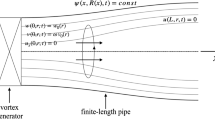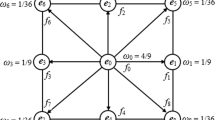Abstract
The flow field of multi-parallelized swirling flow inside a circular pipe was investigated numerically. Two types of swirling flow configuration are considered. One type is the co-rotating type. Four co-rotating swirls are arranged at the vertex position of square in this type. The other type is the counter-rotating type which consists of two pairs of swirls having opposite swirl rotations. Each pair is arranged diagonally at the vertex position of a square. By coupling the discrete vortex method and boundary element method, unsteady flow simulation is performed. Swirl modeling with vortex elements is used in this simulation and its validity is confirmed. From the simulation results, in the co-rotating type, the four swirls interact and their shape is deformed. Each vortex motion vanishes rapidly in the downstream region. Finally, they are turned into a single swirling flow. In counter-rotating type, each vortex motion is maintained a little bit longer than co-rotating type, and their shape is not so deformed. However, the flow patterns are changed completely in the downstream region. The swirling velocity of each swirl mostly vanishes. Finally, they are turned into an axial flow. For the investigation of the mixing promoting effect due to parallelizing swirls, particle tracking simulations are performed in the co-rotating type and the counter-rotating type. As a comparison, the simulation for single swirl flow is also performed. In these simulations, the particles are introduced in the vicinity of pipe inner wall. In addition, the assumption that particles follow the flow motion absolutely is used. From the results, the motion of particles in these three cases is completely different. For the co-rotating and counter-rotating type, the particle entrainment into the main axial flow is clearly observed. This indicates the mixing is improved compared to single swirl flow. The difference of particle entrainment motion between co-rotating and counter-rotating type is slight.
Similar content being viewed by others
References
A. K. Gupta, D. G. Lilley and N. Syred, Swirl flows, ABACUS Press, Cambridge (1984) 172–186.
A. Vineet, D. Manish and L. M. Charles, The effect of swirl on mixing characteristics of turbulent shear layers, 28 th Fluid Dynamics Conference, USA (1997) 1–12.
T. V. Bach and F. C. Couldin, Flow measurement in a model swirl combustor, AIAA J., 20 (5) (1982) 642–651.
S. A. Ahmed and A. S. Nejad, Swirl effects on confined flows in axisymmetric geometries, J., of Propulsion and Power, 8 (1992) 339–345.
D. G. Lilley, Swirling flows in typical combustor geometries, 23 rd Aerospace Science Meeting, Nevada (1985) AIAA-85-0184.
R. Tacina, C. Wey, P. Laing and A. Mansour, A low nox lean direct injection, mulitpoint integrated module combustor concept for advanced aircraft gas turbines, NASA Glenn Research Center Technical Report (2002) NASA/TM-2002-211347.
J. Cai and S. M. Jeng, Multi-swirler aerodynamics: comparison of different configurations, Proc. of ASME Turbo Expo 2002, Netherlands (2002) 739–748.
R. W. Humble, G. N. Henry and W. J. Larson, Space propulsion analysis and design, McGraw-Hill, New York (1995).
D. Saito, S. Yuasa, K. Hirata, T. Sakurai and N. Shiraishi, Combustion characteristics of paraffin-fueled swirling oxidizer-flow-type hybrid rocket engines, 48 th AIAA/ASME/SAE/ASEE Joint Propulsion Conference & Exhibit, Atlanta (2012) AIAA 2012-3904.
Y. S. Chen, Y. Y. Lian, L. Yang and B. Wu, Combustion modeling and analysis of hybrid rocket motor internal ballistics, 48 th AIAA/ASME/SAE/ASEE Joint Propulsion Conference & Exhibit, Atlanta (2012) AIAA 2012-3749.
T. Ishiguro, K. Shinohara, K. Sakio and I. Nakagawa, A study on combustion efficiency of paraffin-based hybrid rockets, 47 th AIAA/ASME/SAE/ASEE Joint Propulsion Conference & Exhibit, San Diego (2011) AIAA 2011-5679.
A. Takayama, Flow dynamics of confined multiple swirling jets under non-reacting conditions, 29 th International Symposium on Space Technology and Science, Nagoya (2013) 2013-s-54-a.
L. Rosenhead, The formation of vortices from a surface of discontinuity, Proceedings of the Royal Society of London, Series A, Containing Papers of a Mathematical and Physical Character, 134 (823) (1931) 170–192.
A. Ojima and K. Kamemoto, Numerical simulation of unsteady flow around three dimensional bluff bodies by an advanced vortex method, JSME International J. Series B, Fluids and Thermal Engineering, 43 (2) (2000) 127–135.
S. A. Sauter and C. Schwab, Boundary element methods, Springer, Berlin (2011).
G. Winkelmans and A. Leonard, Improved vortex methods for three-dimensional flows, Proceedings of the Workshop on Mathematical Aspects of Vortex Dynamics, Leesburg (1988) 25–35.
K. Fukuda and K. Kamemoto, A Lagrangian redistribution model toward the construction of a turbulence model for vortex methods, JSME, 70 (697) (2004) 2311–2318 (in Japanese).
K. Fukuda, Development of a redistribution model for vortex methods and its application to turbulent flow analysis, Ph.D. thesis, Yokohama National University (2005) (in Japanese).
S. V. Alekseenko, P. A. Kuibin, V. L. Okulov and S. I. Shtork, Helical vortices in swirl flow, J. of Fluid Mechanics, 382 (1999) 195–243.
P. Wang, X. S. Bai, M. Wessman and J. Klingmann, Large eddy simulation and experimental studies of a confined turbulent swirling flow, Physics of Fluids, 16 (9) (2004) 3306–3324.
Author information
Authors and Affiliations
Corresponding author
Additional information
This paper was presented at the AJCPP-2014, Jeju Grand Hotel, Jeju, Korea, March 5–8, 2014. Recommended by Guest Editor Heuy Dong Kim
Akimasa Takayama is an Engineer at the Combustion laboratory in Mitsubishi Heavy Industries, Ltd., received the M. S. (Aeronautics) from University of Tokyo (2014). Since 2014, he has been an engineer in Mitsubishi Heavy Industries, Ltd. His main research areas are pulverized coal combustion, developing the next generation super low NOx burner for thermal power plant. His current work is applying large eddy simulation to pulverized coal combustion.
Koki Kitagawa is an Assistant Professor, in the Dept. of Space Flight Systems, Institute of Space and Astronautical Science, JAXA. He has a Ph.D. (Aeronautics) from Tokyo Metropolitan Institute of Technology (2007). Since 2010, he has been an assistant professor in ISAS, JAXA, also, an adjunct assistant professor of the graduate university for advanced studies (2010–2013) and an adjunct assistant professor of UT (2014-). His research area covers combustion and propulsion engineering of hybrid rocket and solid rocket.
Toru Shimada is a Professor in the Dept. of Space Flight Systems Institute of Space and Astronautical Science, JAXA. He has a Ph.D. (Aeronautics) from University of Tokyo (1985). Since 2006, he has been a professor, also, an adjunct professor of UT. His research area covers flow dynamics inside solid/hybrid rocket motors.
Rights and permissions
About this article
Cite this article
Takayama, A., Kitagawa, K. & Shimada, T. Numerical analysis of multi-parallelized swirling flow inside a circular pipe. J Mech Sci Technol 29, 951–962 (2015). https://doi.org/10.1007/s12206-015-0209-8
Received:
Revised:
Accepted:
Published:
Issue Date:
DOI: https://doi.org/10.1007/s12206-015-0209-8




